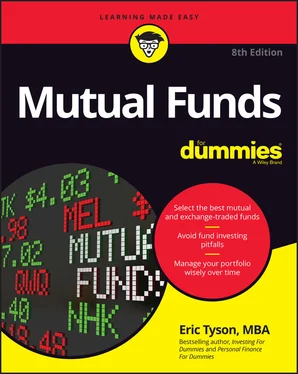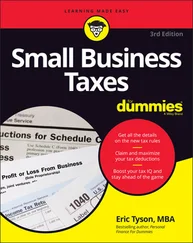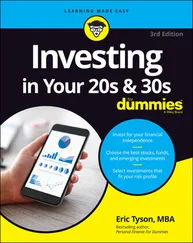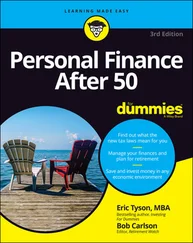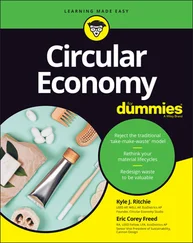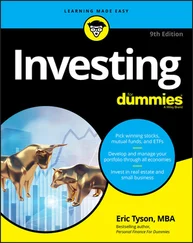Eric Tyson - Mutual Funds For Dummies
Здесь есть возможность читать онлайн «Eric Tyson - Mutual Funds For Dummies» — ознакомительный отрывок электронной книги совершенно бесплатно, а после прочтения отрывка купить полную версию. В некоторых случаях можно слушать аудио, скачать через торрент в формате fb2 и присутствует краткое содержание. Жанр: unrecognised, на английском языке. Описание произведения, (предисловие) а так же отзывы посетителей доступны на портале библиотеки ЛибКат.
- Название:Mutual Funds For Dummies
- Автор:
- Жанр:
- Год:неизвестен
- ISBN:нет данных
- Рейтинг книги:3 / 5. Голосов: 1
-
Избранное:Добавить в избранное
- Отзывы:
-
Ваша оценка:
- 60
- 1
- 2
- 3
- 4
- 5
Mutual Funds For Dummies: краткое содержание, описание и аннотация
Предлагаем к чтению аннотацию, описание, краткое содержание или предисловие (зависит от того, что написал сам автор книги «Mutual Funds For Dummies»). Если вы не нашли необходимую информацию о книге — напишите в комментариях, мы постараемся отыскать её.
Mutual Funds For Dummies
Mutual Funds For Dummies
Mutual Funds For Dummies — читать онлайн ознакомительный отрывок
Ниже представлен текст книги, разбитый по страницам. Система сохранения места последней прочитанной страницы, позволяет с удобством читать онлайн бесплатно книгу «Mutual Funds For Dummies», без необходимости каждый раз заново искать на чём Вы остановились. Поставьте закладку, и сможете в любой момент перейти на страницу, на которой закончили чтение.
Интервал:
Закладка:
They didn’t adjust their spending habits to allow for their increased savings rate. In their enthusiasm to get serious about their savings, they made this error — probably the biggest one of all. Justine and Max thought they were saving more — 12 percent of their income was going into the funds versus the 5 percent they’d been saving in a bank account. However, as the months rolled by, their outstanding balances on credit cards grew. In fact, when they started to invest in funds, Justine and Max had $1,000 of revolving debt on a credit card at a 14 percent interest rate. Six months later, this debt had grown to $2,000.The extra money for investment had to come from somewhere — and in Justine and Max’s case, some of it was coming from building up their credit card debt. But, because their investments were highly unlikely to return 14 percent per year, Justine and Max were actually losing money in the process.
I tell the story of Justine and Max to caution you against buying funds in haste or out of fear before you have your own financial goals in mind.
Lining Up Your Ducks Before You Invest
 The single biggest mistake that fund investors make is investing in funds before they’re prepared — both financially and emotionally. You should get your financial ship in shape — sailing out of port with leaks in the hull is sure to lead to an early, unpleasant end to your journey. And you should determine what you’re trying to accomplish with your investing and what risk you’re comfortable with.
The single biggest mistake that fund investors make is investing in funds before they’re prepared — both financially and emotionally. You should get your financial ship in shape — sailing out of port with leaks in the hull is sure to lead to an early, unpleasant end to your journey. And you should determine what you’re trying to accomplish with your investing and what risk you’re comfortable with.
Throughout this book, I emphasize that particular mutual funds and exchange-traded funds are specialized tools for specific jobs. I don’t want you to pick up a tool that you don’t know how to use. This section covers the most important financial steps for you to take before you invest so you get the most from your fund investments.
Pay off your consumer debts
Consumer debts include balances on credit cards and auto loans. If you carry these types of debts, please do not invest in funds until these consumer debts are paid off. I realize that investing money may make you feel like you’re making progress; paying off debt, on the other hand, just feels like you’re treading water. Shatter this illusion. Paying credit card interest at 14 or 18 percent while making an investment that generates only an 8 percent return isn’t even treading water; it’s sinking! In the world of investing, a 14 to 18 percent guaranteed return is absolutely fantastic so you should not only do that first but feel great about it!
 You won’t be able to earn a consistently high enough rate of return in funds to exceed the interest rate you’re typically paying on consumer debt. Although some financial gurus claim that they can make you 15 to 20 percent per year, they can’t — not year after year. Besides, to try to earn these high returns, you have to take great risk. If you have consumer debt and little savings, you’re not in a position to take that much risk.
You won’t be able to earn a consistently high enough rate of return in funds to exceed the interest rate you’re typically paying on consumer debt. Although some financial gurus claim that they can make you 15 to 20 percent per year, they can’t — not year after year. Besides, to try to earn these high returns, you have to take great risk. If you have consumer debt and little savings, you’re not in a position to take that much risk.
I go a step further on this issue: Not only should you delay any investing until your consumer debts are paid off, but you should also seriously consider tapping in to any existing savings (presuming you’d still have adequate emergency funds at your disposal) to pay off your debts.
Review your insurance coverage
Saving and investing are psychologically rewarding and make many people feel more secure. But, ironically, even some good savers and investors are in precarious positions because they have major gaps in their insurance coverage. Consider the following questions:
Do you have adequate life insurance to provide for your dependents if you die?
Do you carry long-term disability insurance to replace your income in case a disability prevents you from working?
Do you have comprehensive health insurance coverage to pay for major medical expenses?
Have you purchased sufficient liability protection on your home and car to guard your assets and net worth against lawsuits?
 Without adequate insurance coverage, a catastrophe could quickly wipe out your investments. The point of insurance is to eliminate the financial downside of such a disaster and protect your assets.
Without adequate insurance coverage, a catastrophe could quickly wipe out your investments. The point of insurance is to eliminate the financial downside of such a disaster and protect your assets.
In reviewing your insurance, you may also discover unnecessary policies or ways to spend less on insurance, freeing up more money to invest in funds. See the latest edition of my book Personal Finance For Dummies (Wiley) to discover the best ways to buy insurance and whip your finances into shape.
Figure out your financial goals
Mutual funds and exchange-traded funds are goal-specific tools (see the section “ Reaching Your Goals with Funds,” later in this chapter), and humans are goal-driven animals, which is perhaps why the two can make such a good match. Most people find that saving money is easier when they save with a purpose or goal in mind — even if their goal is as undefined as a “rainy day.” Because funds tend to be pretty specific in what they’re designed to do, the more defined your goal, the more capable you are to make the most of your money invested in funds.
Granted, your goals and needs will change over time, so these determinations don’t have to be carved in stone. But unless you have a general idea of what you’re going to do with the savings down the road and in what time frame, you won’t really be able to thoughtfully choose suitable funds. Common financial goals include saving for retirement, a home purchase, an emergency reserve, and so on. In the second half of this chapter, I talk more about the goals funds can help you to accomplish.
Another benefit of pondering your goals is that you better understand how much risk you need to take to accomplish your goals. Seeing the amount you need to save to achieve your dreams may encourage you to invest in more growth-oriented funds. Conversely, if you find that your nest egg is substantial given what your aspirations are, you may scale back on the riskiness of your fund investments.
Determine how much you’re saving
Many folks don’t know what their savings rate is. By savings rate, I mean, over a calendar year, how did your spending compare with your income? For example, if you earned $60,000 last year, and $57,000 of it got spent on taxes, food, clothing, rent, insurance, and other fun things, you saved $3,000. Your savings rate then would be 5 percent ($3,000 of savings divided by your gross (pre-tax) income of $60,000).
If you already know your rate is low, nonexistent, or negative, you can safely skip this step because you also already know you need to save more. But figuring out your savings rate can be a real eye-opener.
Examine your spending and income
To save more, you must reduce your spending, increase your income, or both. This isn’t rocket science, but it’s easier said than done.
 For most people, reducing spending is the more feasible option. But where do you begin? First, figure out where your money is going. You may have some general idea, but you need to have facts. Access your banking records for your checking account, debit card, credit card, and any other documentation of your spending history, and tally up how much you spend on dining out, operating your car(s), paying your taxes, and everything else. When you have this information, you can begin to prioritize and make the necessary trade-offs to reduce your spending and increase your savings rate.
For most people, reducing spending is the more feasible option. But where do you begin? First, figure out where your money is going. You may have some general idea, but you need to have facts. Access your banking records for your checking account, debit card, credit card, and any other documentation of your spending history, and tally up how much you spend on dining out, operating your car(s), paying your taxes, and everything else. When you have this information, you can begin to prioritize and make the necessary trade-offs to reduce your spending and increase your savings rate.
Интервал:
Закладка:
Похожие книги на «Mutual Funds For Dummies»
Представляем Вашему вниманию похожие книги на «Mutual Funds For Dummies» списком для выбора. Мы отобрали схожую по названию и смыслу литературу в надежде предоставить читателям больше вариантов отыскать новые, интересные, ещё непрочитанные произведения.
Обсуждение, отзывы о книге «Mutual Funds For Dummies» и просто собственные мнения читателей. Оставьте ваши комментарии, напишите, что Вы думаете о произведении, его смысле или главных героях. Укажите что конкретно понравилось, а что нет, и почему Вы так считаете.
